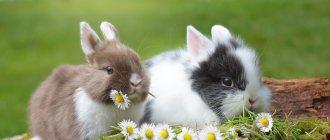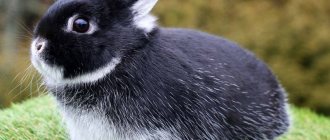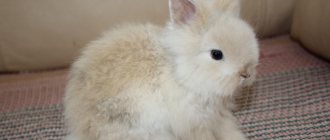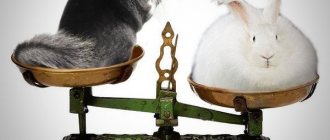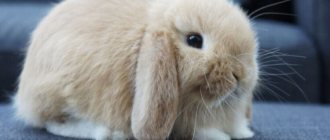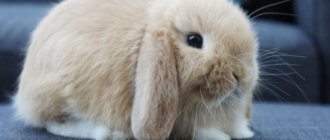If you want to have a small, cute, fluffy animal, then a dwarf rabbit is a great option. In order for the baby to feel good and not get sick, it is important to provide the necessary conditions for him and provide proper care.
What is the difference between decorative rabbits and ordinary ones?
There are many varieties of rabbits. They differ from each other in appearance, weight, size, length of fur and colors. These animals are wild and domestic.
The latter are divided into several types depending on the purpose of breeding:
- Meat. Such animals grow to large sizes, so it is profitable to breed them for dietary meat.
- Fur. Representatives of such breeds can boast of a beautiful coat; they are raised for their skins.
- Downy ones. Bred for fluff. Animal fur does not contain awns, it is delicate and soft. It is used in light industry.
- Decorative. These rabbits are kept as pets, just like cats or dogs.
The main difference between a decorative rabbit and a regular one is its weight and size. The body weight of an adult animal rarely exceeds 3 kg. Rodents that are used in agriculture, especially for meat, weigh on average 3.5-5 kg. And the body weight of Flanders reaches 7-10 kg.
Representatives of decorative breeds have a beautiful appearance. Each has its own characteristics:
- lop-eared;
- the presence of tassels on the ears;
- large round head;
- plush fur;
- miniature size.
Animals that are artificially bred specifically for keeping at home are better socialized. They quickly become attached to their owner and know how to show tenderness. Decorative rabbits are dwarf. The body weight of such rodents varies between 700-1500 g.
Now they are very popular. Children especially love them, because miniature pets evoke affection.
Decorative rabbits cannot be kept outside or on the balcony, unlike ordinary ones. They need a certain temperature, which should range between +17...+25 degrees.
Nutrition and care
You can feed your pet with store-bought food or give it food you prepare yourself. It is believed that ready-made dry food is harmful to decorative rabbits. On this type of diet, rabbits live shorter lives and often die from fatty liver. The reason for this is low-quality and harmful components, additives of animal origin - fish meal, sugar, legumes.
When eating dry food, teeth grinding, which is necessary for health, does not occur. The food itself is little chewed, dissolves in saliva and is quickly swallowed. The stomach and intestines are under heavy stress and lack moisture. Result: flatulence, diarrhea, kidney stones.
The diet of a decorative rabbit should consist of:
- vegetables;
- fresh herbs;
- unlimited amount of hay;
- dry food in very limited quantities;
- clean and soft water.
As for vegetables, fresh carrots of any variety are given all year round. White cabbage, broccoli, Brussels sprouts are given in limited quantities. All year round you can offer Chinese cabbage, dandelion, purslane, and mint. In winter, fodder beet, Jerusalem artichoke, and cauliflower grow well.
In spring, summer and autumn, rabbits are fed coriander, green peas, bell peppers, watercress, and spinach as fresh greens. Favorite delicacies include tops of carrots, beets, leaves of strawberries, raspberries, and sunflowers.
For normal functioning of the digestive system and grinding of teeth, rabbits need to be given hay all year round. If the animal refuses to eat it, it needs to change the composition and texture. Some prefer harder hay, others prefer softer hay. Experts recommend placing hay near the litter box because rabbits like to chew something while sitting on the litter box. Chewing hay takes up a significant portion of a pet's time.
The most popular breeds
There are several dozen breeds of decorative rabbits in the world. All of them were bred by breeders. Many of them have gained great popularity among animal lovers.
Attention! When choosing an animal to keep at home, you need to take into account that long-haired pets are more difficult to care for than short-haired ones.
Colored dwarf
Colored dwarfs are miniature animals whose weight varies within 1 kg. The animal has a cylinder-shaped body, a rounded head, and short ears. The coat is very thick, short and shiny. Caring for decorative rabbits of this breed is not difficult. Colored dwarfs are presented in a wide range of colors. In addition, they have a friendly nature.
Lion head
This decorative rabbit comes from Belgium. Thanks to the thick fur on his head and neck, he looks like a lion. Dwarf lionhead rabbits grow up to 1.5 kg. These are smart, playful animals with a good-natured disposition. Such an animal will become a good friend for children.
Lop-eared ram
Fold sheep are native to France. They have one peculiarity - large hanging ears. Due to the wide forehead, wide-set eyes and dense build, the animal resembles a ram. These pets are easy to care for - their fur, although thick, is not long. Fold sheep can be of a variety of colors - blue, white, gray, yellow.
Hermelin
The breed is of Polish origin. Hermelines are miniature animals weighing 1-1.5 kg. Their body is fit, their head is oval, their ears are erect and small, and their eyes are blue. The coat is short but very thick.
Dutch Fold
Representatives of this breed resemble a plush toy. They have chubby cheeks, drooping ears and beautiful short fur. The rabbit weighs no more than 1.5 kg. These are calm animals that are willing to be held, allow themselves to be petted, and love active games.
Angora dwarf
Such a pet needs to be carefully looked after - it is all covered with long and soft hair, even its ears. A luxurious fur coat should be combed every day, otherwise it will become tangled.
Reference. Decorative rabbits grow until they are six months old, after which weight gain stops.
Hermelin
Origin story.
These animals were bred in the 19th century, but appeared in Russia only recently. The first Hermelins were brought to the Moscow exhibition of miniature rabbits in 1998.
Hermelina is often confused with its close relative, the Polish rabbit . Hermelins are rarely seen in Russia, but they are very popular in England.
Characteristic.
- The weight of these rabbits is about 1 kg.
- The color, according to the standards, is only pure white.
- The eyes must be either red or blue.
- Hermelines are short-haired (length - about 2 mm). The length of the ears is up to 7 cm.
Hermelin rabbits are also called stoats.
Care.
You can bathe your rabbit no more than once a year. During the molting period, be sure to comb once or twice a week. Since hermelins often suffer from obesity, it is very important to properly balance their diet and calculate portions by gram.
Features of behavior
Domestic rabbits communicate with their owners using body language. By carefully observing your pet, you can guess what he wants to say:
- If the animal is completely relaxed, it should not be disturbed. Especially when he's lying on his side and looks like he's dead. In this position he feels most comfortable. Perhaps he felt so comfortable and good that he fell asleep.
- Licking the owner's hands is a sign of special affection. With this behavior, decorative rabbits demonstrate a friendly attitude. After all, when rodents living together clean and wash each other, they show that they recognize that their relative belongs to their pack.
- The decorative rabbit rose on its hind legs and stretched its neck. This means that he is interested in some subject. The pet wants to take a closer look at it or tries to reach for the treat.
- The animal constantly rummages in the litter, as if looking for or hiding something. Most likely, the rodent is building a hole. Females usually do this during nesting.
- The animal puts its muzzle to the palm and pushes. This is how he shows that he wants to receive another portion of affection and attention.
- The pet presses its ears and shrinks into a ball. This indicates severe fear or wariness. Perhaps he saw a stranger or heard a sharp sound. The feeling of danger is always accompanied by instinctive muscle contraction. The animal also flattens its ears when it is angry and ready to fight. At such moments, he raises his muzzle. It is better not to approach your pet, but wait until he calms down, and then treat him to a carrot or other treat.
- A domestic rabbit bit my hand. Obviously he didn't like the rough treatment. A pet may bite when it is forcibly pulled out of its cage or pressed too hard. This is why children should be taught how to properly handle an animal.
- The animal grinds its teeth or makes a quiet muttering sound. This is how the pet shows that he enjoys stroking.
The habits characteristic of most rodents are described above. However, each animal has its own character, so the behavior of decorative rabbits under different circumstances may differ.
Sounds
Rabbits can be said to be almost mute creatures. They occasionally make some sounds. Sometimes you can hear a soft clicking of teeth or something similar to rumbling. This means that the animal feels good, like a cat when it purrs. Loud cries indicate pain.
An interesting fact about domestic rabbits is that they sometimes mumble. Such sounds are most often made by a female rabbit when she feeds her offspring.
Taming Ability
Decorative rabbits are well socialized, but it will take time to adapt. You need to tame your pet immediately after it gets used to the new place a little. The process of getting used to household members lasts from 7 days to 3-4 months, it depends on the character and age of the rodent. Baby rabbits adapt faster, while adults are characterized by greater caution and timidity.
From the first days of being in the house, a decorative rabbit should be called by name. It is better to address him in a gentle and quiet voice so as not to scare him. The owner's movements should be smooth. As soon as your pet gets used to the voice and stops being afraid, you can move on to familiarizing yourself with your hands. This will also take time.
First, it is better to let your fingers and palms smell through the cage and treat the baby rabbit with a treat. When the animal is no longer afraid of hands, you can open the door and gently stroke it. It is important to do this daily until the pet begins to trust its owner.
After this, you can release the animal for a walk outside its home. For the first time, the cage is left open, and the owner must sit nearby and not make sudden movements. Curiosity will certainly force the little rabbit to come out of hiding and look around. The rodent should be rewarded with a piece of treat for its courage. The pet must return to the cage on its own.
Attention! While walking around the apartment, you need to keep an eye on the decorative rabbit. If he is left unattended, he may fall from a height, chew wires or furniture.
Pygmy fox
Origin story. The breed was developed in Austria in 1992.
Characteristic.
- Dwarf foxes are among the five smallest decorative breeds of rabbits. Their weight rarely reaches more than half a kilogram.
- The animals are normal-haired, the hair length is from 3.5 to 7 mm.
- The coat color of dwarf foxes is very diverse. But the white and red ones are most valued.
Care.
These rabbits should only be washed in extreme situations. Claws need to be sharpened 2-3 times a week. The coat should be brushed regularly.
How many years do decorative rabbits live?
The average lifespan of domestic rodents is 8-10 years. Dwarf rabbits live a little less - 7-8 years. Much depends on the conditions in which the animal is kept. With good care, long-eared pets rarely die before the allotted time.
The lifespan of an animal is influenced by the following factors:
- Lifestyle. The rabbit needs to move a lot. Physical activity will help speed up your metabolism and avoid weight gain.
- Diet. Rabbits have a sensitive digestive system, so it is important to monitor your pet's diet.
- Conditions of detention. The rodent must be protected from hypothermia, overheating, temperature changes, and dampness, otherwise it may get sick and die.
- Castration. Veterinarians say that spayed and neutered rabbits live on average 1-2 years longer.
A caring owner can prolong the life of his pet. What is needed for this:
- keep the animal in a spacious cage;
- feed correctly, do not give prohibited foods;
- Vaccinate your rabbit in a timely manner;
- monitor the cleanliness of the rodent’s body and home;
- protect him from stressful situations.
The approach of old age is indicated by changes in the behavior of the decorative rabbit. Over time, his activity decreases, he ceases to be interested in games. In older animals, their fur thins, their eyes become cloudy, and their muscles weaken. But we must remember that in old age a pet needs the love and care of its owner even more.
Emotions
Rabbits make different sounds, you can hear:
- grunting;
- whining;
- growl;
- loud grinding of teeth.
This indicates irritation, dissatisfaction or malaise. If you frighten a pregnant rabbit, she may lose her offspring. As for the male, he will simply die of fear, and this is not an exaggeration. Signs of fear:
- eye rolling;
- growl;
- loss of appetite;
- stamping feet.
So it's better to be kinder to them. Under natural conditions, all predators are taller than lagomorphs, so lifting an eared animal upward can greatly frighten it.
Interesting Facts
Those who want to know everything about decorative rabbits should study 11 interesting facts about them:
- Despite the fact that these animals are often called rodents, they actually belong to the order Lagomorpha.
- Rabbits have a special digestive system. They do not know how to regurgitate food, so a hairball or foreign object that gets into the stomach can lead to the most tragic consequences.
- Rabbits grow incisors throughout their lives, so they need to constantly grind them down. To satisfy this need, the animal gnaws on branches, cage bars, and while walking it can taste furniture, shoes, and even wires lying on the floor.
- The decorative rabbit has 28 teeth - 6 incisors and 22 cheeks.
- Puberty comes early. Already at the age of 3 months, rabbits can begin to reproduce.
- Pregnancy lasts about a month. Cubs are born blind and deaf, unlike hares.
- Mature males tend to defend their territory, so they can be aggressive. However, after castration, the character of decorative rabbits becomes softer and more flexible.
- These animals are quite smart. The animal can be trained to use the tray and even follow simple commands; it quickly remembers its nickname and responds to it.
- Decorative rabbits need physical activity, you need to give them the opportunity to walk every day.
- The animals are most active at dusk.
- Rodents can see everything to the side or behind, but they cannot see directly in front of them. The location of the eyes does not allow them to do this. Rabbits do not have a clear image; they see the world as if in a blurry picture.
How to pick up
This is especially useful for children. An interesting fact about rabbits is that any careless gesture is perceived almost as an attack. It is better not to pick up your pet at first.
Let the coward get used to it and get used to it. What to do:
- Handle carefully. The animal's bones are very fragile and can be broken.
- You can't lift him by the ears - it hurts.
- You shouldn't grab him by the withers either. The rabbit may start to struggle and injure its neck.
It is best to hold the furry creature in one hand and hold it with the other.
There are many different breeds of rabbits, but the Angora is especially popular.

